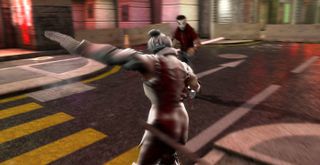Mastering Blade Symphony: part one

This diary series was written for the UK magazine last summer: issues 268 and 269, to be precise. The game has been updated several times since then, so long-term Blade Symphony players may notice a few discrepancies.
Swords are cool. I’d like to be more intellectual about it, but there you go. Blade Symphony is a game that takes that sentiment to heart. It is a lean, razorsharp successor to the Jedi Knight series, stripping out anything that isn’t to do with swordfighting and closing in hard on the particular thrill of facing another person in a one-on-one online duel.
It’s about the way duels express the personality of the duellist, and about the social structures that form when people have such a striking way of establishing primacy over one another. In Blade Symphony, you bow before you try to kill somebody. You accept advice from high-ranked people when it’s offered. You seek out opponents who can teach you something, and you aim for the top.
Blade Symphony uses the Elo rating system to determine each player’s global rank. That means the game keeps track of who is expected to come out on top of a given fight based on their past performance, and when the results don’t correlate with what the game expected, a player’s rating is adjusted accordingly. These individual ratings are then compared across everybody playing the game, and players are sorted into leagues based on the percentage of the population that they fall into.
The lowest ranking players play in the Oak league. Above that is Iron, and then the top 25 per cent are Steel. Climb into the top six per cent and you can call yourself Diamond. The very best players, the ones who can hold a duelling pitch for an entire game, and command the most respect in free-for-all practice servers, are Masters. They’re the top 1 per cent, and at that point you’re talking about ranks in the double digits.

A few hours into my time with Blade Symphony, I started to win. I started to see how the game fitted together, how I fitted with it, how I could make it do what I wanted it to do. Then, I decided that I wanted to become a Master. I set myself at the bottom of the ladder and prepared to climb. This diary is the story of that attempt.
Players in Blade Symphony select a character which determines a moveset, and a sword that determines the parameters of how that moveset is used. I fenced in real life for a little under three years. I was never particularly good, but I was fairly quick, small and left-handed—and all of those things helped me confuse opponents enough to land a respectable number of hits. For that reason, I’ve chosen to make the climb to Master as Phalanx, Blade Symphony’s foilist. His attacks are quick, long-reaching and direct, but he relies on misdirection and staying out of reach to survive.
The biggest gaming news, reviews and hardware deals
Keep up to date with the most important stories and the best deals, as picked by the PC Gamer team.
I like to end fights quickly whenever I can, and the devastating power of Phalanx’s lunge can do that.
I’m using a rapier for similar reasons. It does more damage on thrusting strikes and can nimbly redirect incoming blows. I like to end fights quickly whenever I can, and the devastating power of Phalanx’s lunge can do that. The rapier is also underrated as a slashing weapon, I think: the damage might not be there, but nobody expects it, and doing the unexpected is a great way to gain the upper hand.
After 20 hours with the game I’d hit the heights of Diamond twice. After the second time I crashed hard. I started to lose and didn’t really know why. I saw strategies I couldn’t deal with and my ranking plunged all the way back down to Oak. After hours of work, I’ve pulled myself back up to Steel. I’m 2,048th in the world as my climb begins.

In order to improve my Elo rating I need to duel other Steel league players on ranked servers. Fighting anybody else will be useful practice, but finding—and beating—those Steel players is the important thing. Waiting for an opponent gives me time to get my eye in. I hold the duelling ground for five games against other Phalanx players before losing to a Ryoku player, a nimble freeform swordsman whose radial attack patterns are hard to predict. I take one game off him by playing dirty, making to step back for a lunge before stepping in, grabbing him, and finishing him with a strike while he’s down. He takes the next one: I’m too used to deflecting direct strikes to cope with his flanking manoeuvres.
But that’s practice. My first Steel opponent is another foilist. He has a Dota avatar and, from watching him fight other players, he relies heavily on a string of fast forward attacks to needle opponents to death. This is a hard strategy for new players to deal with, which I imagine is why he’s in Steel league. He destroys a player using the Wushu swordswoman Pure before I face him. I’m a little nervous: it’s easy to mess up against Phalanxes, and I really don’t want to go back to Iron.
As predicted he comes at me fast and direct, wanting to land that first fast strike. I step back and use the same combo, landing the first hit as he overextends. He takes the same damage he was planning to dish out to me. After four hits he rolls out of the way and comes in again, fast. I parry to the side and roll back, using the roll to mask my switch to balanced stance. I come up into a hard lunge that hits him in the chest. The third part of his fast combo connects, but I parry right then left and hit him fast and forward. He crumples. Round two.
Joining in 2011, Chris made his start with PC Gamer turning beautiful trees into magazines, first as a writer and later as deputy editor. Once PCG's reluctant MMO champion , his discovery of Dota 2 in 2012 led him to much darker, stranger places. In 2015, Chris became the editor of PC Gamer Pro, overseeing our online coverage of competitive gaming and esports. He left in 2017, and can be now found making games and recording the Crate & Crowbar podcast.
Most Popular
